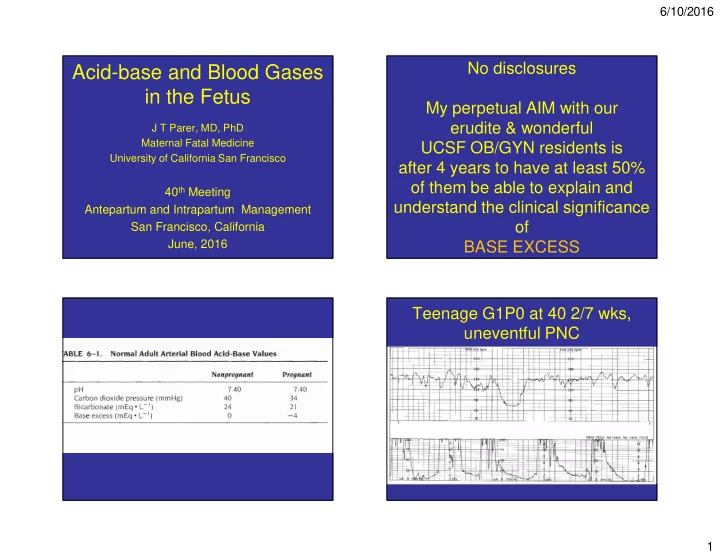

6/10/2016 No disclosures Acid-base and Blood Gases in the Fetus My perpetual AIM with our erudite & wonderful J T Parer, MD, PhD Maternal Fatal Medicine UCSF OB/GYN residents is University of California San Francisco after 4 years to have at least 50% of them be able to explain and 40 th Meeting understand the clinical significance Antepartum and Intrapartum Management of San Francisco, California June, 2016 BASE EXCESS Teenage G1P0 at 40 2/7 wks, uneventful PNC 1
6/10/2016 SVD at 08:52 What is pH? pH is the negative log, to the base 10, of the concentration of [H+] ions The Dreaded Henderson- Hasselbalch Equation Concentration of acid, or hydrogen ions, or [H + ] in blood: 0.0000004 mM/lit or 4 X 10 -7 or 10 -7.4 The pH is therefore 7.4 2
6/10/2016 Henderson-Hasselbalch Equation For convenience this is changed to negative logarithm notation: Henderson-Hasselbalch • -log [H+]= -log K + log [base]/[acid] Equation - acid base pair: For the H 2 CO 3 and HCO 3 - ]/H 2 CO 3 ] • pH= pK + [HCO 3 [H+] = K.[acid]/[base] • pH= 6.1 + log 24/1.2 • = 6.1 + log 20 • = 6.1 + 1.3 • = 7.4 Normal Values for Arterial Blood I can easily and comfortably in Adults define Base Excess Nonpreg Pregnant A. True 86% pH 7.40 7.40 B. False PCO 2 mmHg 40 34 - mM/lit HCO 3 24 20 14% BE mM/lit 0 -4 3
6/10/2016 Summary of normal values in utero Nicholaides et al, 1986 Umbilical Artery Umbilical Vein Mean ± 2 SD Mean ± 2 SD pH 7.33 ± 0.07 7.38 ± 0.06 Carbon dioxide pressure 45 ± 10 38 ± 8 (mmHg) Bicarbonate (mEq • L –1 ) 23 ± 5 23 ± 5 Base excess (mEq • L –1 ) – 3 ± 3 +0.5 ± 4 Oxygen content (mM • L –1 ) 6.7 ± 0.6 ─ Oxygen pressure (mmHg) 35 ± 15 41 ± 20 Hemoglobin (g • dl –1 ) 13 13 The Tyranny of 3 Variables: - and H 2 CO 3 pH, HCO 3 4
6/10/2016 Before & after labour Rooth et al, 1972 Respiratory acidosis is due to Before Labor Second Stage of Labor CO 2 pH 7.37 7.30 Carbon dioxide 38 43 Metabolic acidosis is caused pressure (mmHg) (mainly) by lactic acid Bicarbonate (mEq • L –1 ) 21 21 Base excess (mEq • L –1 ) –3 –5 Normal Values for Arterial Blood Blood Gases in Adults Umb artery Umb vein Nonpreg Pregnant pH 6.88 6.91 pH 7.40 7.40 PCO 2 mmHg 112 99 PCO 2 mmHg 40 34 - mM/lit HCO 3 20 20 - mM/lit HCO 3 24 20 Base Excess -13 -13 mM/lit BE mM/lit 0 -4 5
6/10/2016 Base Excess - can change in 2 ways: Bicarbonate, HCO 3 • By reacting with fixed acids, eg lactic, beta hydroxybutyric, acetoacetic acids - • By changes in CO 2 ; if more CO 2 , higher HCO 3 - ] is only useful as a measure of • Because of this [HCO 3 metabolic acid derangement when PCO 2 is 40 mmHg • Base Excess/Base Deficit was introduced as a measure of metabolic change from normal, even in the presence of CO 2 changes from normal Umbilical blood gases from Threshold of Acceptable Acidemia in clamped segment of cord at birth Umbilical Arterial Blood at Birth n=15000 normal births, Helwig Mean Standard Median 2.5 %tile 97.5th %tile Deviation UA pH 7.26 0.07 7.27 7.10 7.38 • pH > 7.1 UA pCO 2 (mmHG) 53 10 52 35 74 UA pO 2 (mmHG) 17 6 17 6 30 UA base excess –4 3 –4 –11 1 • Base excess >-12 meq/lit (mEQ • L –1 ) UV pH 7.34 0.06 7.35 7.20 7.46 UV pCO 2 (mmHg) 41 7 41 28 57 Helwig et al, AJOG UV pO 2 (mmHG) 29 7 29 16 43 UV base excess –3 3 –3 –8 2 (mEQ • L –1 ) 6
6/10/2016 FHR Management- King’s Kascade Category I Category II Category III IIa Recurrent deceleration s and IIb Decelerations getting deeper +/- tachycardia and IIb Variability diminishin g Expectant Conservative management Conservative measures consider measures Bedside and Intermittent Consult and make evaluation by Deliver as reevaluate in auscultation a plan for clinicians soon as short period reevaluation in Consider possible of time short period of delivery in short 26 time period of time Pathologic fetal acidemia pH < 7.0 BE < -12, or -16, or -20 • Goldaber • Gilstrap • Goodwin • Low 7
6/10/2016 SVD at 08:52 Newborn Cooling Protocol Blood Gas Criteria pH < 7.0 BE< -12 Blood Gases The most likely outcome for this Umb artery Umb vein baby is: pH 6.88 6.91 48% 43% A. Brain damage PCO2 mmHg 112 99 B. Impossible to say HCO3- mM/lit C.Normal outcome 9% Base Excess -13 -13 mM/lit 8
6/10/2016 SVD at 08:52 Rate of change after acute cessation of oxygen delivery in a monkey fetus- Myers pH fell 0.04 units/min CO2 increased 6 mmHg/min Base Excess fell ca 1 mEq/lit/min SVD at 08:52 I am now much more comfortable 3270 gm girl defining and understanding the clinical significance of fetal Base Apgars 1, 7, 10 Excess 60% A. True 40% Glucose @ 30 min-14 B. False Glucose @ 2 hrs-66 Home age 18 hrs 9
6/10/2016 THANK YOU! Fick equation Cardiac output = (O2 consumption) / (arterio- venous O2 concentration difference) or O2 consumption = (cardiac output) x (A-V O2 difference) 10
Recommend
More recommend